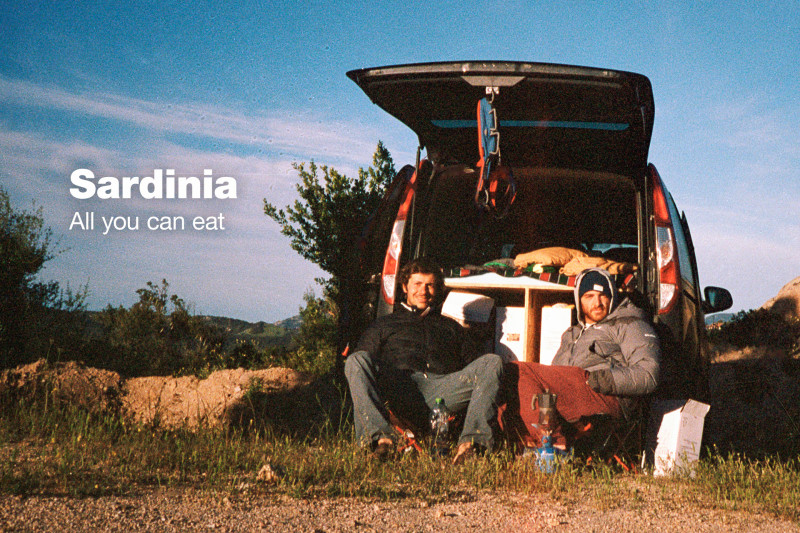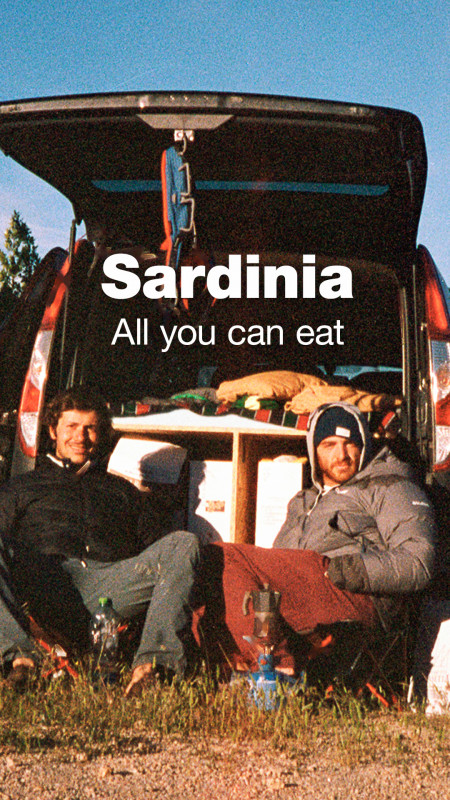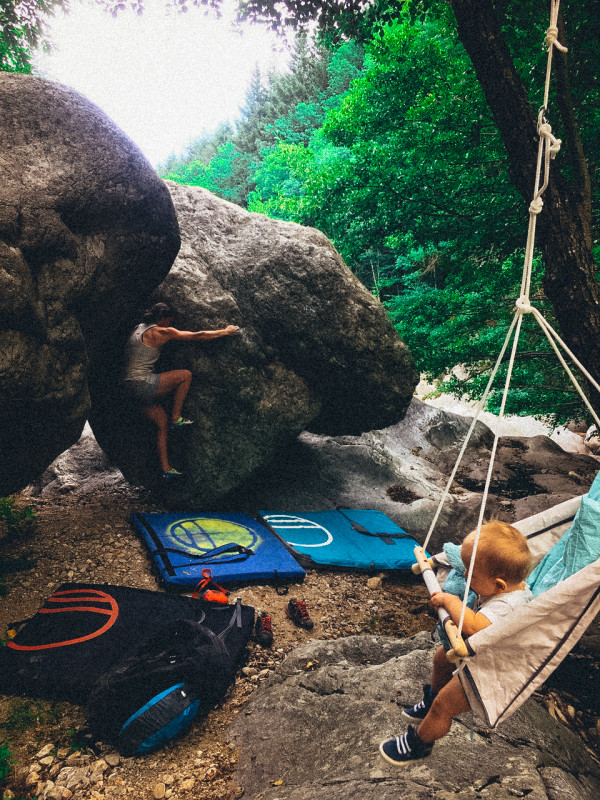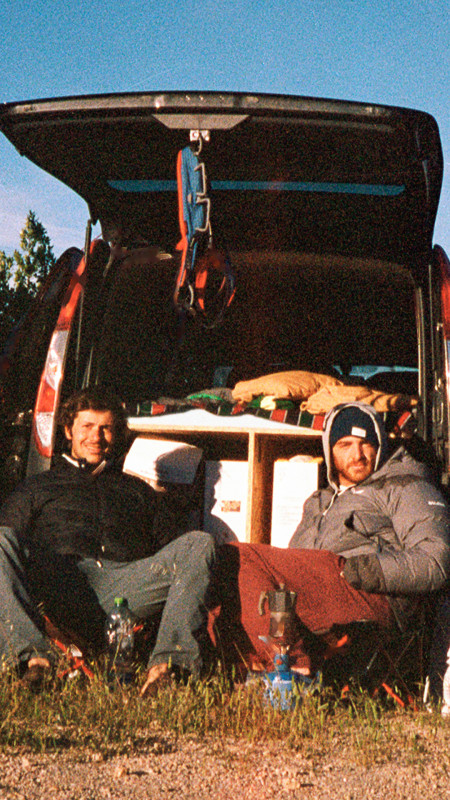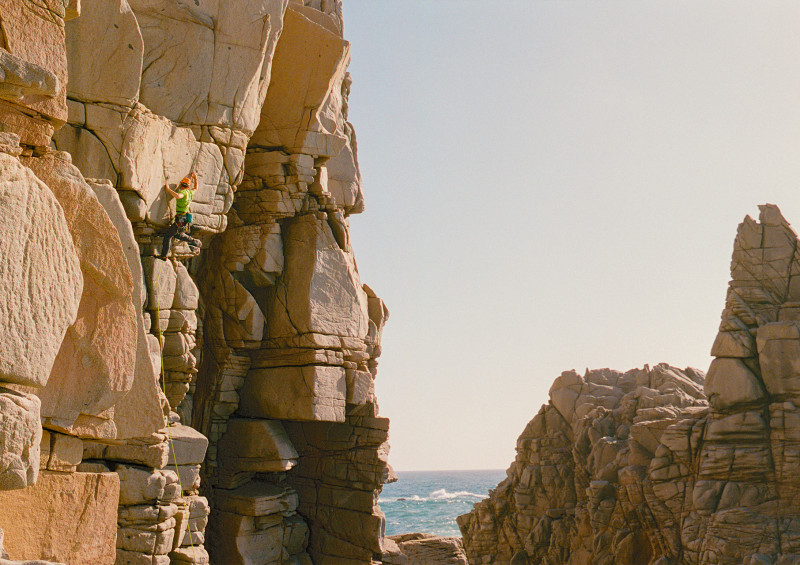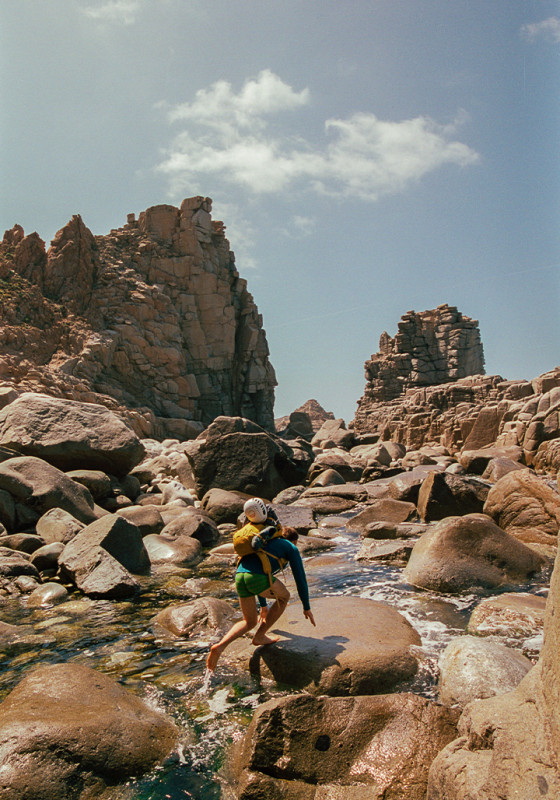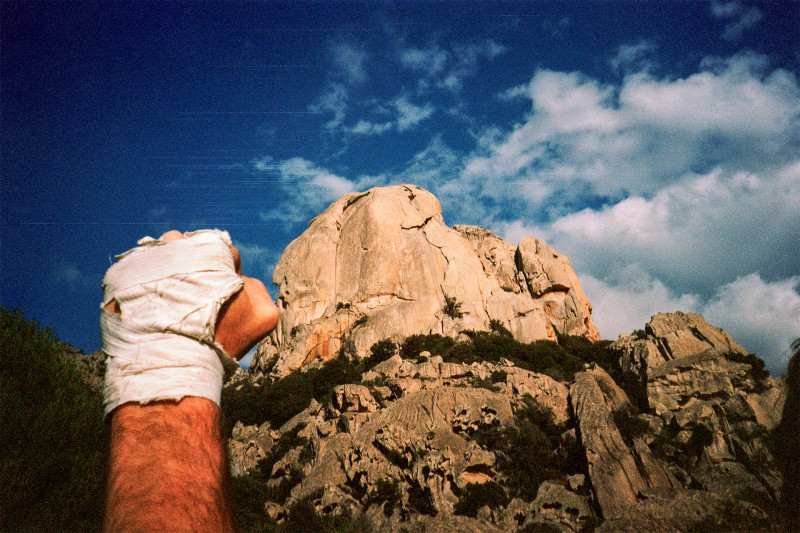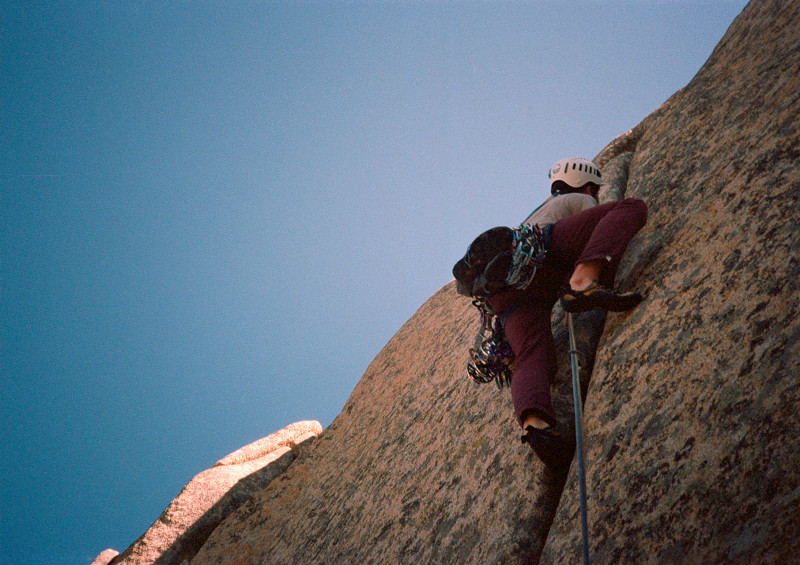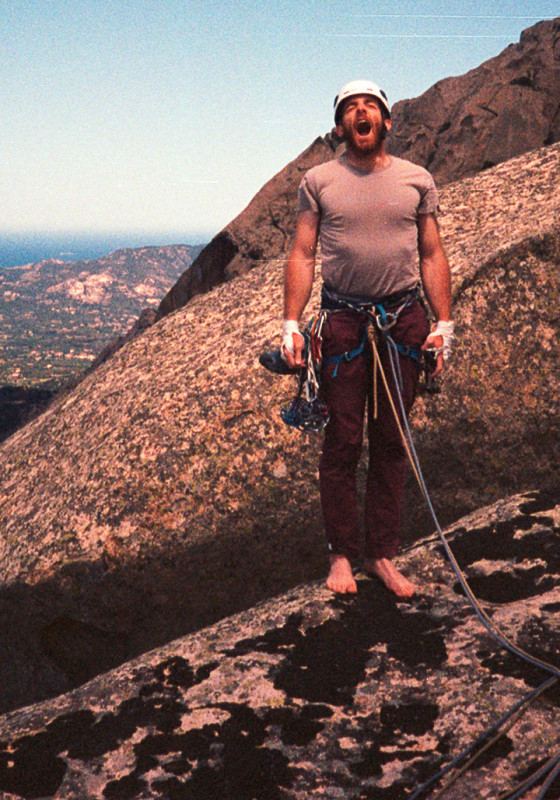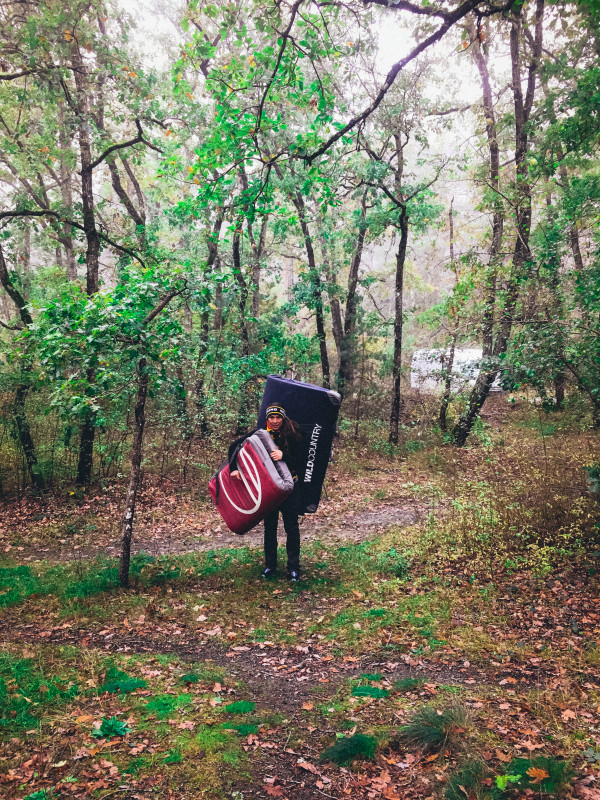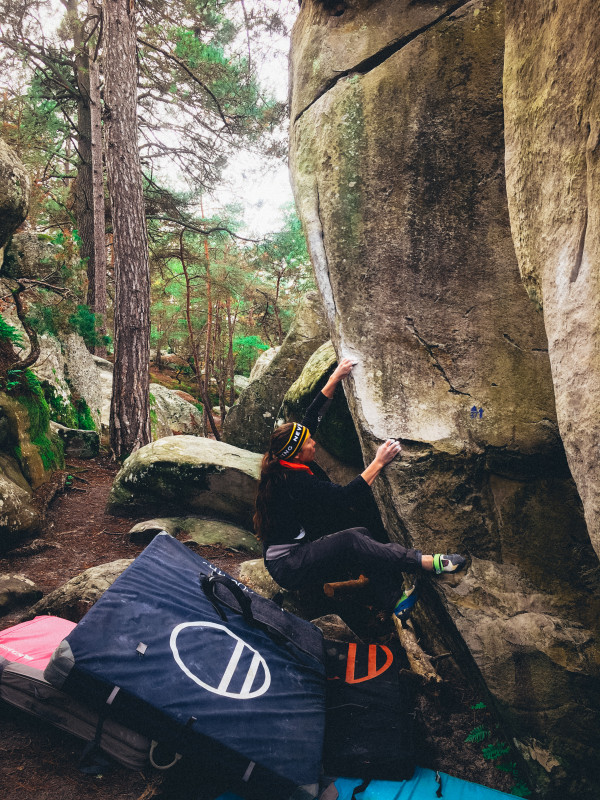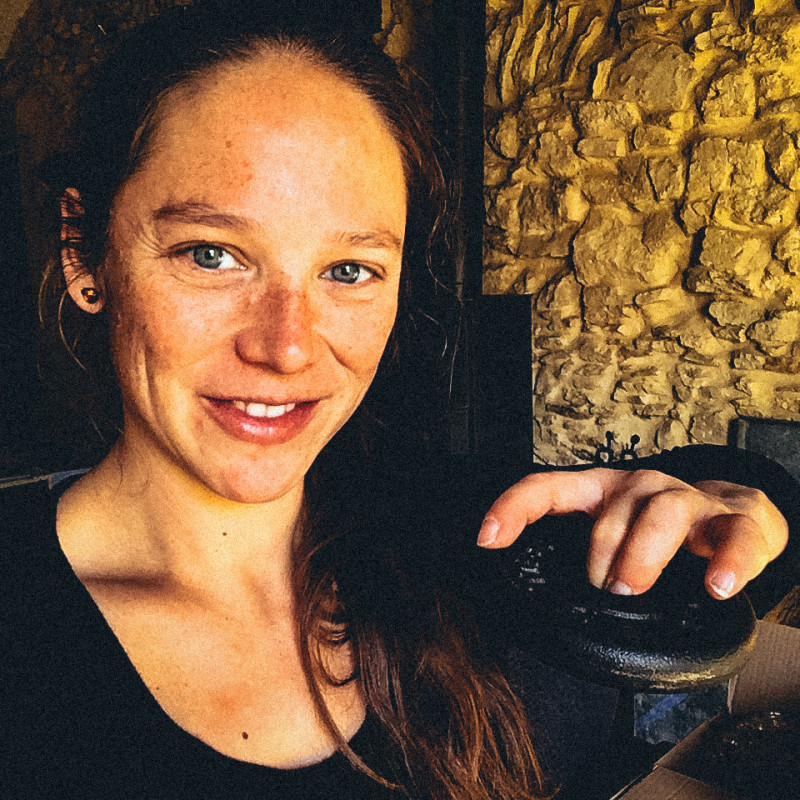translation needed
Translation needed
There are not many words that could do justice to the beauty of this place, particularly the stretch of coast that you must walk before you get to the real cliff face. The collective image of climbing in Sardinia is based on great limestone faces and wild woods. Yet here, you could be in Ireland, if it weren't for the scents of the Mediterranean scrub. When we were there, the rough sea and the light at sunset made it all the more thrilling. And as the only spectators to this natural spectacle, our emotions intensified.
Climbing is a funny game. There are days when you just feel heavy and clumsy. The only memory you take home is your frustration, which makes you ignore all the rest. Yet there are the other days when "the rest" makes you happy, despite the fact that you are tackling climbs that are not much beyond beginner’s standard. And in the afternoon, in Capo Pecora, when the sun dips in the sky and the waves swell, “the rest" transforms into golden light and the smell of salt, which you savour while looking for the best piece to protect you on the white and grey granite with one hand.
On the ninth day, we were forced to raise the white flag. We started having pains here, there and everywhere. This, combined with the sluggish pace at which we ate our breakfast told us that perhaps it would have been best to do something else. First and foremost, we had to clean our camp, which meant the - possibly futile - attempt to make some sense of the disorder in our minivan. Because, after all, to climb you need to welcome disorder into your life. You take holidays at odd times of the year. You grumble when your "normal" friends ask if you'll be heading to the mountains this weekend as well. Then, we tried to figure out how best to use the day. And that’s how we ended up walking among the murals of Orgosolo. This town, situated in the heart of Supramonte, has a bloody past of clan wars and shoot-outs, which has been replaced by a present filled with art and gastronomy. If we’re being honest, we also ended up tasting Cannonau wine and feeling decidedly out of place. The neat clothing of the French group that was with us clashed with our dirty trousers and ruffled hair. Yet we were all in agreement when it came to how delicious the wine was.
The last day was perhaps the best of our trip. It was also maybe because we had absolutely no expectations on what awaited us. The destination was the panettone-shaped rock of Lu Lurusincu, in Gallura, a few kilometres from the port of Olbia. The guidebook merely observed that it was one of the most beautiful granite rock faces on the island. Beyond that, we didn't find anything else.
A search on the internet turned up hardly any information, and little else on the massif of Torri di San Pantaleo. At this point, it was worth going to have a look, armed with friends, as many as possible, and cordelettes, given that in Gallura most of the routes have no pitons, belay stations included, and often the descents on foot are more complicated than the climbs, as well as the approaches. And so it was, almost by chance, that we ended up climbing the perfect crevice of Il passo del giaguaro: There were 45 metres of handholds and fist jams, followed by two slab pitches where it was crucial that we trusted our feet and stayed calm. The whole experience was so amazing that we did it a second time. We then moved on to the Fessura del Traditore, which was also incredible. Then we had to run for the van, without even having time to take off our harnesses. Unfortunately, we had to catch the ferry.
Sardinia gave us what we wanted: a series of excellent routes, in the widest range of styles, where we were almost always alone. Of course, the world of climbing can do without our (meagre) performances. In the end, however, we won’t be the ones who will push the level forward. At most, us common mortals are responsible for defending the fundamental values of this game, which - in some ways - also make up its rules: curiosity, friendship, love for our surroundings and, more than anything else, a desire to get lost.

Sardinia - All you can eat
Granite, basalt, limestone, multi-pitch climbs, bolted single pitches, trad cliff faces and bouldering rocks.
Blog and photos by Federico Ravassard
Goal Setting
To begin, whether you are recovering from an injury (large or small), or in my case returning after pregnancy, goal setting is vital to staying motivated and excited. The level you used to be at might feel as far away as the moon, so instead of focusing on this point, it is essential to set small achievable goals. These goals could be as simple as a few pull-ups, or 5-minutes on the bouldering wall. Set your goals, at the right distance – hard enough, but attainable. In this way, you can celebrate each achievement and continually reset the bar, instead of falling short and becoming disheartened. Of course, the bigger dream - the one of returning to your former level will always be there, at least in the back of your mind. But treat this as a dream, maybe you'll get there, perhaps you won't. What matters, for now, are your small goals.
Next, it is important to listen to your body. I know this is not breaking news, but as you begin recovery, give yourself the time to build strength without causing further injuries. This part can be hard, as it is challenging to find the balance between stopping at every odd twitch and working through what is bound to be discomfort. But give yourself the time to start slow. In the beginning, your muscles are weak, your tendons are weak, and often your motivation is high. This combination is the perfect recipe for injuring healthy body parts. Focusing on your small goals can help ensure you aren't pushing past your limits too soon.
It is also important to pay attention to your psyche. I have found that getting fresh mentally can be the best part of recovery training! If you are feeling drained and your motivation is low, take a break. This will pay off tenfold in the end. Whereas forcing your training can quickly lead to lost motivation.
YOUR TRAINING METRICS ARE IRRELEVANT
CAROLINE CIAVALDINI'S FORMULA TO RECOVERING BETTER, HEALTHIER AND MORE MOTIVATED
by Caroline Ciavaldini
5.0 minute read
Sitting on the floor of her home bouldering room, Caroline Ciavalidini starts laughing, and exclaims, "I can't believe how hard this feels, I know these moves are easy, but I can't keep my feet on the wall. I'm barely lasting 5 minutes in this manner."
This was the scene 1.5 months after the birth of Caroline Ciavaldini' and James Pearson's first child, aptly nicknamed Mini-Monkey. While she was able to climb through the early months of her pregnancy, she eventually took a forced break due to the natural effect of pregnancies, such as the tearing of abdominal muscles. This break has left her slowly working back into climbing in a way she "equates to coming back from a long-term injury." But the energy and excitement she has towards her current level of climbing rarely falter.
In hopes of helping anyone in the Wild Country community with their own recovery, we asked Caroline for some insights into her approach.
Expectation Setting
This next part might be the most essential practice in my recovery - remove any expectations that you have around what your climbing should be. Think back to when you first began climbing. You didn't have any expectations, right? You didn't pressure yourself to climb at a specific level or meet a certain standard. You just wanted to progress as much as possible, you set goals one after the other, you learned, and you absolutely enjoyed it. So now, why don't you approach it as if you were a beginner? Remove your previous expectations and be curious to see where you will get each day. But of course, you now also have a secret weapon that will help you improve faster – your knowledge of climbing techniques.
Lastly, use your recovery training as an opportunity to remind yourself that strong in climbing is relative; difficulty depends on your style, your strengths, and your weaknesses, so solely chasing numbers is not a very accurate goal. Instead, focus on working specific strengths or weaknesses to help you return to the climbs you enjoy. For example, in the past, I chose climbs not off-grade or newsworthy ascents, but routes that draw me in with beautiful lines, curious movements, and above all, a particular historical aura. To be able to once again dedicate myself to these projects, my goal isn't fixed around a specific grade. Instead, it is on being fit, being able to project, try hard and focus on a route. This requires fitness but also on being mentally prepared and motivated.
"As I returned to climbing, I knew it was going to take a lot of work to get back to any familiar level. I had lost my core strength, my arm and finger strength was minimal, and I had not once in my entire adult life felt this weak. I wasn't deflated, though. I have learned a lot through climbing, and whether I am healthy or not, using this knowledge to stay motivated and enthusiastic is a continual practice."
Training Plan
To help you better understand some of my small goal setting steps, and I mean really small steps, I want to show you what I focused on for my strength training and the routines I put in place to accomplish these goals.
1st Goal Routine
One week after Mini Monkey was born, I began a series of arm movement exercises as one of the few things I could safely do. My goal was to work on the different stabilizer muscles in the shoulder, bicep, and triceps at low intensity. I did 6-reps of Butterfly movement with a 0.5kg weight, resting 2-minutes between each set. It was taking about 20-minutes to complete, and if possible, I would do this 2-times per day.
2nd Goal Routine
When I got the green light from my doctor that I could start climbing, about 1.5 months post-birth, I began a small routine on my home wall. My goal was simple, stay on the wall for 5-minutes doing movements. If I felt up to it, I would try to do this for 5-sets with 10-minute breaks between sets. I mostly climbed on the less steep parts, but occasionally, I ventured onto the steep wall for a few short moves. Overall, this recruited all of my body's muscles and really got my core started again. My core was so weak that at the beginning, this was difficult to do.
3rd Goal Routine
When I began to feel solid again around 4-months post-pregnancy, I started a pull-up, pushup, and dip pyramid routine. My goal was to allow myself the time and space to start simple, and I began with pushups on my knees and pull-ups with an elastic band. I strived to flow between each exercise, working my way up to 6-reps and then back down again. Each number increase was a set, and I would rest for 2-minutes between sets. Eventually, I could do the routine without aids and worked my way up to 10-reps, which left me very satisfied!
The Final Stage
It has been one year since the birth of Mini-Monkey, and this has added a beautiful addition to my learning process. As for my recovery training, I feel strong. Just as with any goal, though, my idea of strong is about setting expectations. I am pretty sure I won't be returning to my competitor's level; I won't be able to do finals and podiums in Lead World Cups, and that is fine by me! I am not interested in training 5-hours every day anymore, and mainly, other goals make me dream big!
A current goal I am working on is to explore more bouldering. For sure, this is the most accessible climbing discipline with a baby. But also, I have never made the time to focus on bouldering. It is something I have wanted to do for a long time, and I have a lot to learn; it is exciting! So this is where my climbing goals are right now.
I hope you have found some of these tips helpful, and always remember, be patient with yourself and enjoy your climbing; it should be fun. After all, isn't that why we do it?
Your Training Metrics Are Irrelevant
Caroline Ciavaldini's Formula to Recovering Better, Healthier and More Motivated
Sitting on the floor of her home bouldering room, Caroline Ciavalidini starts laughing, and exclaims, "I can't believe how hard this feels, I know these moves are easy, but I can't keep my feet on the wall. I'm barely lasting 5 minutes in this manner."
This was the scene 1.5 months after the birth of Caroline Ciavaldini' and James Pearson's first child, aptly nicknamed Mini-Monkey. While she was able to climb through the early months of her pregnancy, she eventually took a forced break due to the natural effect of pregnancies, such as the tearing of abdominal muscles. This break has left her slowly working back into climbing in a way she "equates to coming back from a long-term injury." But the energy and excitement she has towards her current level of climbing rarely falter.
In hopes of helping anyone in the Wild Country community with their own recovery, we asked Caroline for some insights into her approach.
Caroline on Recovery Training
"As I returned to climbing, I knew it was going to take a lot of work to get back to any familiar level. I had lost my core strength, my arm and finger strength was minimal, and I had not once in my entire adult life felt this weak. I wasn't deflated, though. I have learned a lot through climbing, and whether I am healthy or not, using this knowledge to stay motivated and enthusiastic is a continual practice."
Goal Setting
To begin, whether you are recovering from an injury (large or small), or in my case returning after pregnancy, goal setting is vital to staying motivated and excited. The level you used to be at might feel as far away as the moon, so instead of focusing on this point, it is essential to set small achievable goals. These goals could be as simple as a few pull-ups, or 5-minutes on the bouldering wall. Set your goals, at the right distance – hard enough, but attainable. In this way, you can celebrate each achievement and continually reset the bar, instead of falling short and becoming disheartened. Of course, the bigger dream - the one of returning to your former level will always be there, at least in the back of your mind. But treat this as a dream, maybe you'll get there, perhaps you won't. What matters, for now, are your small goals.
Next, it is important to listen to your body. I know this is not breaking news, but as you begin recovery, give yourself the time to build strength without causing further injuries. This part can be hard, as it is challenging to find the balance between stopping at every odd twitch and working through what is bound to be discomfort. But give yourself the time to start slow. In the beginning, your muscles are weak, your tendons are weak, and often your motivation is high. This combination is the perfect recipe for injuring healthy body parts. Focusing on your small goals can help ensure you aren't pushing past your limits too soon.
It is also important to pay attention to your psyche. I have found that getting fresh mentally can be the best part of recovery training! If you are feeling drained and your motivation is low, take a break. This will pay off tenfold in the end. Whereas forcing your training can quickly lead to lost motivation.
Expectation Setting
This next part might be the most essential practice in my recovery - remove any expectations that you have around what your climbing should be. Think back to when you first began climbing. You didn't have any expectations, right? You didn't pressure yourself to climb at a specific level or meet a certain standard. You just wanted to progress as much as possible, you set goals one after the other, you learned, and you absolutely enjoyed it. So now, why don't you approach it as if you were a beginner? Remove your previous expectations and be curious to see where you will get each day. But of course, you now also have a secret weapon that will help you improve faster – your knowledge of climbing techniques.
Lastly, use your recovery training as an opportunity to remind yourself that strong in climbing is relative; difficulty depends on your style, your strengths, and your weaknesses, so solely chasing numbers is not a very accurate goal. Instead, focus on working specific strengths or weaknesses to help you return to the climbs you enjoy. For example, in the past, I chose climbs not off-grade or newsworthy ascents, but routes that draw me in with beautiful lines, curious movements, and above all, a particular historical aura. To be able to once again dedicate myself to these projects, my goal isn't fixed around a specific grade. Instead, it is on being fit, being able to project, try hard and focus on a route. This requires fitness but also on being mentally prepared and motivated.
Training Plan
To help you better understand some of my small goal setting steps, and I mean really small steps, I want to show you what I focused on for my strength training and the routines I put in place to accomplish these goals.
1st Goal Routine
One week after Mini Monkey was born, I began a series of arm movement exercises as one of the few things I could safely do. My goal was to work on the different stabilizer muscles in the shoulder, bicep, and triceps at low intensity. I did 6-reps of Butterfly movement with a 0.5kg weight, resting 2-minutes between each set. It was taking about 20-minutes to complete, and if possible, I would do this 2-times per day.
2nd Goal Routine
When I got the green light from my doctor that I could start climbing, about 1.5 months post-birth, I began a small routine on my home wall. My goal was simple, stay on the wall for 5-minutes doing movements. If I felt up to it, I would try to do this for 5-sets with 10-minute breaks between sets. I mostly climbed on the less steep parts, but occasionally, I ventured onto the steep wall for a few short moves. Overall, this recruited all of my body's muscles and really got my core started again. My core was so weak that at the beginning, this was difficult to do.
3rd Goal Routine
When I began to feel solid again around 4-months post-pregnancy, I started a pull-up, pushup, and dip pyramid routine. My goal was to allow myself the time and space to start simple, and I began with pushups on my knees and pull-ups with an elastic band. I strived to flow between each exercise, working my way up to 6-reps and then back down again. Each number increase was a set, and I would rest for 2-minutes between sets. Eventually, I could do the routine without aids and worked my way up to 10-reps, which left me very satisfied!
The Final Stage
It has been one year since the birth of Mini-Monkey, and this has added a beautiful addition to my learning process. As for my recovery training, I feel strong. Just as with any goal, though, my idea of strong is about setting expectations. I am pretty sure I won't be returning to my competitor's level; I won't be able to do finals and podiums in Lead World Cups, and that is fine by me! I am not interested in training 5-hours every day anymore, and mainly, other goals make me dream big!
A current goal I am working on is to explore more bouldering. For sure, this is the most accessible climbing discipline with a baby. But also, I have never made the time to focus on bouldering. It is something I have wanted to do for a long time, and I have a lot to learn; it is exciting! So this is where my climbing goals are right now.
I hope you have found some of these tips helpful, and always remember, be patient with yourself and enjoy your climbing; it should be fun. After all, isn't that why we do it?

